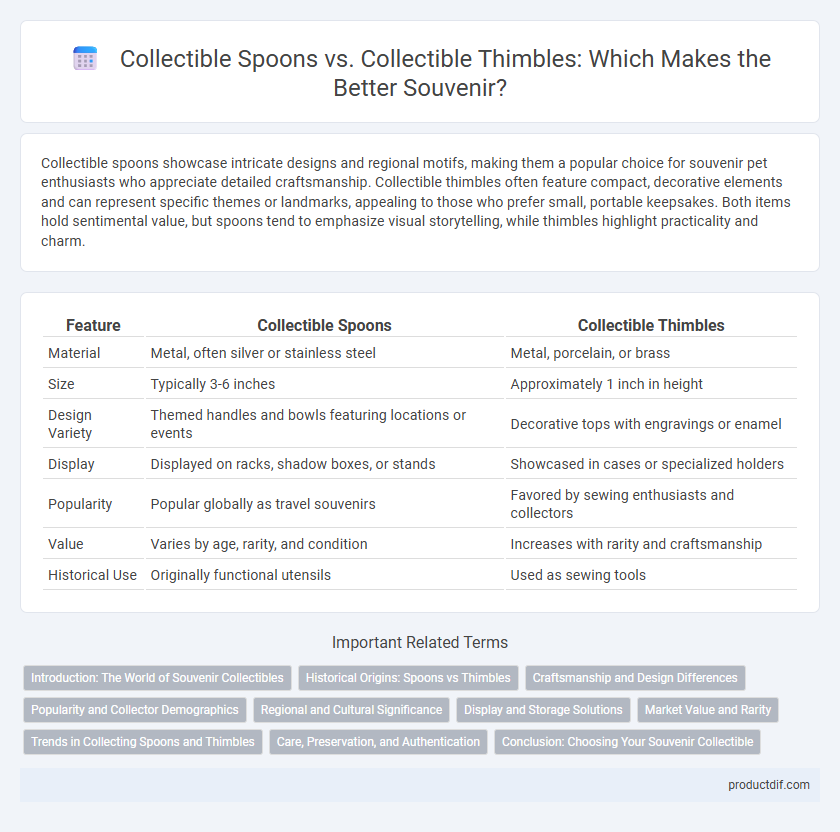Collectible spoons showcase intricate designs and regional motifs, making them a popular choice for souvenir pet enthusiasts who appreciate detailed craftsmanship. Collectible thimbles often feature compact, decorative elements and can represent specific themes or landmarks, appealing to those who prefer small, portable keepsakes. Both items hold sentimental value, but spoons tend to emphasize visual storytelling, while thimbles highlight practicality and charm.
Table of Comparison
| Feature | Collectible Spoons | Collectible Thimbles |
|---|---|---|
| Material | Metal, often silver or stainless steel | Metal, porcelain, or brass |
| Size | Typically 3-6 inches | Approximately 1 inch in height |
| Design Variety | Themed handles and bowls featuring locations or events | Decorative tops with engravings or enamel |
| Display | Displayed on racks, shadow boxes, or stands | Showcased in cases or specialized holders |
| Popularity | Popular globally as travel souvenirs | Favored by sewing enthusiasts and collectors |
| Value | Varies by age, rarity, and condition | Increases with rarity and craftsmanship |
| Historical Use | Originally functional utensils | Used as sewing tools |
Introduction: The World of Souvenir Collectibles
Collectible spoons and thimbles are iconic souvenirs that capture cultural heritage, historical events, and artistic craftsmanship in miniature form. Spoons often feature engraved landmarks or city names, making them popular keepsakes for travelers seeking tangible memories. Thimbles appeal to collectors through their intricate designs and metalwork, symbolizing both traditional sewing tools and decorative artifacts from around the world.
Historical Origins: Spoons vs Thimbles
Collectible spoons date back to ancient civilizations where they were crafted from precious metals and often engraved to commemorate significant events or royal households, symbolizing status and heritage. Collectible thimbles originated in the Middle Ages as practical sewing tools made from brass or silver, evolving into decorative items adorned with intricate designs and enamel, reflecting the artistry of different cultures. Both spoons and thimbles serve as tangible connections to historical craftsmanship and social customs, with spoons emphasizing ceremonial use and thimbles highlighting domestic and artistic heritage.
Craftsmanship and Design Differences
Collectible spoons often showcase intricate metalwork with detailed engravings, featuring materials like silver or enamel to highlight regional motifs and historical landmarks. In contrast, collectible thimbles emphasize fine porcelain or brass craftsmanship, frequently adorned with miniature paintings or embossed patterns reflecting cultural heritage. The design of spoons tends toward practical elegance, while thimbles prioritize ornamental complexity and delicate artistry.
Popularity and Collector Demographics
Collectible spoons enjoy broader popularity due to their association with diverse travel destinations and historical events, attracting a wide demographic ranging from casual tourists to serious memorabilia enthusiasts. Collectible thimbles appeal more to niche collectors, often those with interests in sewing history or vintage decorative arts, typically skewing towards older adults and craft aficionados. Market trends indicate spoons have higher liquidity and resale value, reflecting their widespread demand and diverse collector base.
Regional and Cultural Significance
Collectible spoons and collectible thimbles both carry rich regional and cultural significance, often featuring designs emblematic of specific locales or cultural heritage. Spoons frequently depict landmarks, city names, or iconic symbols tied to the region, while thimbles showcase traditional patterns, motifs, or materials reflective of local craftsmanship and customs. Collectors value these items not only for their aesthetic appeal but also for their ability to preserve and celebrate distinct cultural identities across various global communities.
Display and Storage Solutions
Collectible spoons often feature flat handles and shallow bowls, making them ideal for display on wall-mounted racks or in glass-front cabinets that highlight intricate designs and enamel detailing. Collectible thimbles, with their compact cylindrical shape, require individual compartments or cushioned trays within display cases to prevent damage and allow easy viewing of fine craftsmanship and unique patterns. Both items benefit from UV-protected displays and controlled humidity environments to preserve metal finishes and painted surfaces over time.
Market Value and Rarity
Collectible spoons often command higher market value due to their detailed craftsmanship and association with specific landmarks or events, making them highly sought after by tourists and collectors. Collectible thimbles, while rarer in some cases, tend to have niche appeal, with value largely dependent on material, age, and unique designs representing historical or cultural significance. Both collectibles benefit from limited editions and provenance, but spoons generally outperform thimbles in liquidity and broader market demand.
Trends in Collecting Spoons and Thimbles
Collectible spoons have gained popularity due to their detailed engravings and association with travel destinations, becoming a favorite among tourists and hobbyists alike. Collectible thimbles appeal largely to vintage enthusiasts and seamstresses, with handcrafted designs and limited editions driving their value. Trends indicate a growing online marketplace for both spoons and thimbles, fueled by social media communities sharing rare finds and historical significance.
Care, Preservation, and Authentication
Collectible spoons require gentle cleaning with mild soap and soft cloths to preserve intricate designs and enamel finishes, while collectible thimbles benefit from avoiding moisture and abrasive materials to maintain their delicate metalwork or porcelain. Proper storage in padded cases or display cabinets with controlled humidity extends the lifespan of both items, preventing tarnish on spoons and cracks on thimbles. Authentication involves examining maker's marks, provenance, and material composition, with thimbles often identified by porcelain stamps and spoons by hallmarks or engravings.
Conclusion: Choosing Your Souvenir Collectible
Collectible spoons offer detailed engravings and varied international designs, making them ideal for travelers seeking a visual story of destinations. Collectible thimbles appeal to enthusiasts interested in craftsmanship and historical significance, often featuring intricate patterns and precious materials. Selecting your souvenir collectible depends on personal taste, space considerations, and the desire to reflect cultural heritage or aesthetic preferences.
Collectible spoons vs Collectible thimbles Infographic

 productdif.com
productdif.com